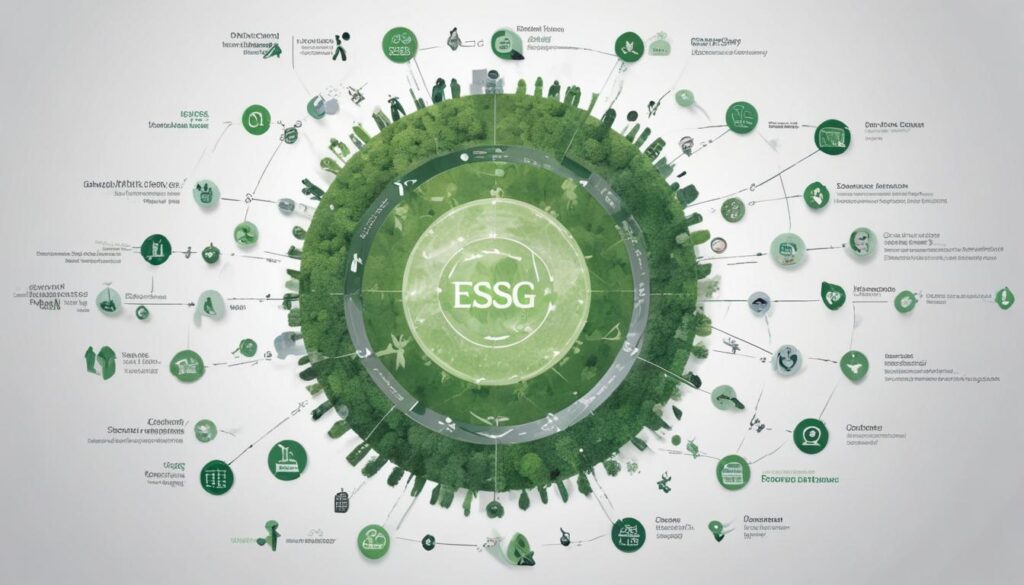ESG data collection involves gathering information on environmental, social, and governance practices to enhance transparency, comply with regulations, and build stakeholder trust, utilizing technologies like AI and blockchain to improve accuracy and efficiency.
ESG data collection is essential for businesses aiming to enhance their accountability. But how exactly is this data gathered and verified? Let’s dive into the details!
Understanding ESG data collection processes
Understanding ESG data collection processes is crucial for organizations aiming to achieve transparency and accountability in their operations. Companies utilize various methods to gather ESG data, focusing on accuracy and relevance. This data often encompasses environmental impact, social responsibility, and governance practices.
Effective collection typically involves:
- Identifying key performance indicators (KPIs) that reflect the organization’s ESG goals.
- Utilizing technology, such as software tools and platforms, to automate data gathering and ensure real-time updates.
- Engaging stakeholders, including employees, investors, and the community, to facilitate feedback and enhance data accuracy.
- Implementing standardization protocols to ensure consistency in data reporting across different departments and regions.
In addition, third-party verification plays a vital role in validating ESG data. Independent audits help assure investors and stakeholders that the data reported is factual and reliable. Companies must remain vigilant about regulatory changes that could impact their ESG reporting standards.
Ultimately, building a robust ESG data collection framework not only fosters compliance but also enhances corporate reputation and stakeholder trust. By prioritizing these processes, organizations can effectively communicate their sustainability efforts and long-term commitments.
The role of technology in ESG verification
The role of technology in ESG verification is increasingly essential as organizations strive for transparency in their practices. Advanced technologies streamline the verification process, ensuring that data is not only collected accurately but also analyzed efficiently.
Key technologies utilized in ESG verification include:
- Blockchain: Enhances data integrity by providing immutable records that stakeholders can trust.
- Artificial Intelligence: Automates data analysis, helping identify patterns and anomalies that require attention.
- Data Analytics Tools: Aggregate and interpret vast amounts of data, making it easier to evaluate ESG performance.
- Cloud Computing: Facilitates collaboration and real-time data access across teams and locations.
Moreover, RegTech solutions are emerging to help companies comply with regulatory standards effectively. These technologies assist organizations in monitoring changes in legislation and ensuring adherence to updated ESG requirements. By adopting technology in these ways, businesses can foster trust with investors and consumers alike.
Ultimately, integrating technology into ESG verification processes not only enhances accuracy but also drives innovation. As technology continues to evolve, it will further shape the landscape of sustainability and corporate responsibility.
Key challenges in collecting ESG data

Collecting ESG data presents several key challenges that organizations must navigate to ensure effective reporting and compliance. These obstacles can hinder the accuracy and reliability of the data collected.
Some of the most prevalent challenges include:
- Lack of Standardization: ESG metrics often vary widely across industries, making it difficult to compare data effectively.
- Data Quality Issues: Inconsistent data sources can lead to discrepancies in reporting, impacting credibility.
- Resource Constraints: Many organizations lack the necessary tools and trained personnel to gather and analyze ESG data efficiently.
- Regulatory Complexity: Keeping up with changing regulations related to ESG can be a daunting task for businesses.
- Stakeholder Expectations: Companies face pressure from investors and consumers to provide comprehensive and transparent ESG reporting.
Addressing these challenges requires a strategic approach. Organizations can benefit from:
- Investing in technology to automate data collection and reporting processes.
- Establishing clear guidelines for data standardization across departments.
- Engaging with external experts to ensure compliance and enhance data integrity.
By tackling these challenges head-on, businesses can improve their ESG data collection processes and strengthen their sustainability initiatives.
Case studies of successful ESG data practices
Exploring case studies of successful ESG data practices provides valuable insights into how organizations effectively manage their sustainability efforts. These examples highlight best practices, innovative approaches, and the positive impacts of robust ESG reporting.
One notable case is that of a major corporation that implemented a comprehensive ESG strategy. Their approach included:
- Data Integration: They consolidated data from various departments, creating a unified platform that enhanced transparency and accessibility.
- Stakeholder Engagement: Regular dialogues with stakeholders allowed the company to align its ESG initiatives with community expectations and investor demands.
- Third-party Audits: By engaging independent auditors, they ensured the credibility of their ESG reports, building trust with investors and consumers.
Another example involves a technology firm that utilized advanced analytics for real-time ESG reporting. Their success stemmed from:
- Automation: Leveraging AI tools to automate data collection significantly reduced errors and time spent on reporting.
- Employee Training: They invested in training programs to educate employees about the importance of ESG data, fostering a culture of accountability.
These case studies not only illustrate effective tactics but also emphasize the importance of commitment and continuous improvement in achieving sustainability goals.
Regulations influencing ESG reporting
Regulations play a critical role in shaping ESG reporting, driving companies to disclose their environmental, social, and governance practices transparently. With increasing global attention on sustainability, numerous regulations have emerged to ensure compliance and accountability.
Key regulations influencing ESG reporting include:
- EU Taxonomy Regulation: Establishes a framework to classify sustainable economic activities, guiding investors in their decision-making.
- Securities and Exchange Commission (SEC) Guidelines: In the U.S., the SEC is pushing for enhanced disclosure related to ESG factors that may affect investment risks.
- Global Reporting Initiative (GRI): Provides widely accepted standards for sustainability reporting, enabling organizations to measure and communicate their ESG performance.
- Sustainable Finance Disclosure Regulation (SFDR): Requires financial market participants to disclose how they integrate ESG factors into investment decisions.
Organizations must stay current with these regulatory frameworks to avoid penalties and enhance their reputations. Compliance not only mitigates risks but also demonstrates a commitment to sustainable business practices.
As regulations evolve, companies should consider adopting proactive measures, such as improving data collection processes and enhancing stakeholder engagement, to stay ahead in their ESG initiatives.
Future trends in ESG data collection

Future trends in ESG data collection are set to reshape how organizations report their sustainability efforts and enhance transparency. As the demand for accountability grows, several emerging trends will likely influence the landscape.
One significant trend is the increased use of artificial intelligence and machine learning. These technologies will allow companies to automate data collection and analysis, leading to more accurate and timely reporting. Key advantages include:
- Improved data accuracy by minimizing human error.
- Real-time insights into ESG performance, enabling quicker decision-making.
- Better identification of patterns and anomalies within the data.
Another trend is the rise of blockchain technology, which enhances data verification and security. By providing a transparent and immutable record of transactions, blockchain can build trust among stakeholders and reduce the risk of data manipulation.
Furthermore, the integration of Internet of Things (IoT) devices will enable organizations to collect real-time data on environmental impacts, such as carbon emissions and energy consumption. This data will empower companies to measure their sustainability efforts more effectively.
In summary, embracing these trends will help organizations not only comply with regulations but also foster a culture of sustainability and innovation.
In Summary: The Future of ESG Data Collection
Understanding and improving ESG data collection is essential for organizations aiming to build trust and accountability. As regulations evolve and stakeholder expectations grow, adopting effective practices becomes crucial.
By leveraging technology, such as AI, blockchain, and IoT, companies can enhance their data accuracy and transparency. Learning from successful case studies, organizations can overcome challenges and foster a culture of sustainability.
As we move forward, staying informed about trends and adopting innovative solutions will help businesses not only comply with regulations but also demonstrate their commitment to responsible practices. Embracing these changes is vital to thriving in today’s competitive landscape.
In conclusion, the journey towards effective ESG data practices is ongoing, but the benefits are significant for both organizations and their stakeholders.
Frequently Asked Questions
What is ESG data collection?
ESG data collection refers to the process of gathering information related to a company’s environmental, social, and governance practices to assess their sustainability performance.
Why is ESG data collection important for businesses?
It enhances transparency, builds trust with stakeholders, and helps organizations comply with regulations, ultimately leading to better decision-making.
What technologies improve ESG data collection?
Technologies like artificial intelligence, blockchain, and IoT devices enhance data accuracy, verification, and real-time monitoring of sustainability metrics.
How can companies overcome challenges in ESG data collection?
By investing in appropriate technology, standardizing data processes, and engaging stakeholders, companies can address common challenges in ESG data collection.
What regulations impact ESG reporting?
Regulations such as the EU Taxonomy Regulation and SEC Guidelines influence how companies disclose ESG information, requiring greater accountability and transparency.
What are the future trends in ESG data collection?
Future trends include increased automation, the use of advanced analytics, and the integration of IoT devices, all aimed at enhancing sustainability reporting and compliance.


